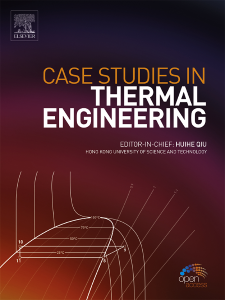Evaluation of photovoltaic thermal system performance with different nanoparticle sizes via energy, exergy, and irreversibility analysis
IF 6.4
2区 工程技术
Q1 THERMODYNAMICS
引用次数: 0
Abstract
The PVT system efficiency generally depends on diverse factors, such as design parameters, solar radiation intensity, and the concentration and type of nanofluid, among other major factors. The present work focuses on the effect of nanoparticle size on a nanofluid-based PVT collector system with a spiral-flow absorber. Besides nanoparticle size, the system is experimentally investigated at various flow rates, nanoparticle concentrations, and different working conditions. Moreover, PV efficiency is also calculated and compared with thermal efficiency by employing both energy and exergy analyses. The rate of exergy loss in PVT is calculated in order to provide a appropriate understanding of the key factors that affect the overall performance of such systems. The most important factor significantly affecting the PVT net efficiencies is the absorber outlet temperature, which illustrates the trade-off between the temperature increase and the increase of the potential concentration factor.通过能量、放能和不可逆分析评估不同纳米粒子尺寸的光伏热系统性能
PVT 系统的效率通常取决于多种因素,如设计参数、太阳辐射强度、纳米流体的浓度和类型等主要因素。本研究的重点是纳米粒子尺寸对基于纳米流体的螺旋流吸收器 PVT 集热系统的影响。除纳米粒子尺寸外,还在不同流速、纳米粒子浓度和不同工作条件下对该系统进行了实验研究。此外,还计算了光伏效率,并通过能量和放能分析与热效率进行了比较。通过计算 PVT 的放能损失率,可以适当了解影响此类系统整体性能的关键因素。对 PVT 净效率有重大影响的最重要因素是吸收器出口温度,这说明了温度升高与潜在浓缩因子增加之间的权衡。
本文章由计算机程序翻译,如有差异,请以英文原文为准。
求助全文
约1分钟内获得全文
求助全文
来源期刊

Case Studies in Thermal Engineering
Chemical Engineering-Fluid Flow and Transfer Processes
CiteScore
8.60
自引率
11.80%
发文量
812
审稿时长
76 days
期刊介绍:
Case Studies in Thermal Engineering provides a forum for the rapid publication of short, structured Case Studies in Thermal Engineering and related Short Communications. It provides an essential compendium of case studies for researchers and practitioners in the field of thermal engineering and others who are interested in aspects of thermal engineering cases that could affect other engineering processes. The journal not only publishes new and novel case studies, but also provides a forum for the publication of high quality descriptions of classic thermal engineering problems. The scope of the journal includes case studies of thermal engineering problems in components, devices and systems using existing experimental and numerical techniques in the areas of mechanical, aerospace, chemical, medical, thermal management for electronics, heat exchangers, regeneration, solar thermal energy, thermal storage, building energy conservation, and power generation. Case studies of thermal problems in other areas will also be considered.
 求助内容:
求助内容: 应助结果提醒方式:
应助结果提醒方式:


